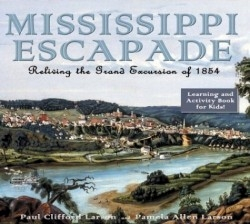Mississippi Escapade
Reliving the Grand Excursion of 1854
For four days in June of 1854, twelve hundred passengers on seven steamboats chugged up the Mississippi River from Illinois, past Iowa and Wisconsin, and into the Minnesota Territory, during the “Grand Excursion of 1854.”
The passengers-journalists, scientists, public figures, ministers, a former president (Millard Fillmore) and his 22-year-old daughter-were guests of the Chicago and Rock Island Railroad, invited to celebrate the laying of the final link of rail connecting the country’s east coast to the Mississippi River.
The Upper Mississippi river valley, “one of the scenic wonders of the American continent,” had been largely unseen except by Native Americans, explorers, French fur traders, soldiers, and a few steamboat pilots. This escapade was about to change all that.
The authors have created an active learning book for kids ages nine through twelve, with information relevant to older readers and adults as well. Paul Larson is an award-winning public historian and the author of several regional histories, including Minnesota Architect: The Life and Work of Clarence H. Johnston and A Place at the Lake. Pamela Larson teaches at St. Paul’s Linwood A+ School.
Beginning with a brief history of the native peoples of the area, the Larsons explain in easy language how river transportation evolved from the canoe to the keelboat to log rafts to the steamboats on which the travelers began their journey upriver at Rock Island, Illinois. It’s noted that barely sixty years earlier, this was the site of Saukenuk, the Sac (Sauk) capital, one of the largest Indian centers in North America.
The authors intersperse the story of the excursionists? trip with the history behind the river towns they traveled through. For instance, a Vermont blacksmith started a lucrative business in Moline (from the French moulin, meaning “mill”), Illinois. His name was John Deere.
Readers learn of the competitive nature between towns across the river from each other. For instance, LaCrosse, Wisconsin was named for a popular Indian ball game, but the settlers on the opposite side in Minnesota thought that the town had taken its name from the Christian symbol on banners during the Crusades in the Middle Ages. So they chose the symbol on Muslim army banners during that time and called their town LaCrescent.
The book is filled with photos of breath-taking vistas, as well as activities that tie in with the reading. It would have been interesting to read more about some of the individual travelers, although readers do learn that Abby Fillmore contracted cholera a month after the trip and died.
One excursionist calls the landscape that he?’s seen “unimaginable fairy-land, genie land, and world of visions.”
Reviewed by
Robin Farrell Edmunds
Disclosure: This article is not an endorsement, but a review. The publisher of this book provided free copies of the book to have their book reviewed by a professional reviewer. No fee was paid by the publisher for this review. Foreword Reviews only recommends books that we love. Foreword Magazine, Inc. is disclosing this in accordance with the Federal Trade Commission’s 16 CFR, Part 255.

